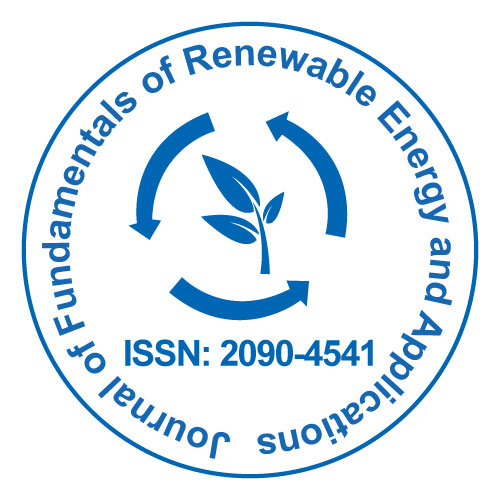
Journal of Fundamentals of Renewable Energy and Applications
Open Access
ISSN: 2090-4541
+44 1300 500008

ISSN: 2090-4541
+44 1300 500008
Commentary - (2023)Volume 13, Issue 3
Bioplastics are plastics produced from natural materials such as vegetable oils and starches. Because bioplastics are plant-based, the consumption of petroleum for plastic production is anticipated to fall by 15%-20% by 2025. Drop in bioplastics are bioplastics that are chemically identical to their fossil fuel counterparts but are produced from renewable resources. Bio-PE, bio-PET, bio-propylene, bio-PP, and bio-based nylons are a few examples. Drop-in bioplastics are theoretically simple to implement because existing infrastructure can be used.
Impact of bioplastics on environment
Bioplastics create mostly the plastic problem and the climatic changes in the environment, which are discussed briefly in the commentary.
The 'plastic issue'
Plastic pollution in the environment has become a top priority for key global organisations such as the United Nations, the World Economic Forum (WEF), the world health organization, and the European Union. (EU). Rather than recycling or reusing products, the plastics industry has typically used mostly linear processes focused on extracting raw materials and converting them into usable products. Since 1950, the non-fiber plastics market has been led by PE (36.4%), polypropylene (PP; 21%), and polyvinylchloride (PVC; 12%), while the fibers market is dominated by polyethylene terephthalate (PET; 70%). In 2015, the commercial industries with the highest worldwide plastic volumes were packaging (35.9%), construction (16.0%), textiles (14.5%), and consumer goods (10.3%).
Plastics are also used extensively in the automotive, electronics, and agricultural sectors (for example, 10.1%, 6.2%, and 3.4% in the EU in 2016). Packaging is the leading source of waste worldwide, accounting for 146 million tonnes produced in 2015, 141 million tonnes of which went unrecycled (96.6%). Packaging also has the shortest average working life of any industrial plastic industry. The working life of single use plastics, from use to disposal, can be as brief as a few minutes.
Because of poor refuse management, 1% to 5% of all plastic winds up as waste in terrestrial and, in particular, oceanic environments. Approximately 80% of oceanic plastic detritus originates on land, most commonly from poorly managed landfills and kerbsides that are ravaged by sea tides and wind. Every year, approximately two million tonnes of plastic debris leach into rivers, both in developing countries with inadequate collection and refuse treatment facilities and in industrialized nations such as China and the United States. This problem is exacerbated by 'external dumping,' or the shipment of plastic from wealthier nations to those with inadequate waste management infrastructure and laws. The UN member states are now addressing this issue through the 2019 basel convention's plastic waste amendments, which aim to control global plastic waste trade.
Submerged plastic debris can suffocate marine life in oceanic settings. Furthermore, microplastic particles, which range in size from 1 to 5 mm and are usually produced by abrasion and Ultraviolet (UV) light degradation, can move up the food chain; microplastic particles can now be found in tap water, air, fish, and salt. Because of their particulate structure and ability to collect and transport contaminants such as additives and hydrophobic organic chemicals, these particles have the potential to be harmful. The vast majority (98%) of oceanic microplastic particles originate from land-based sources, primarily washing synthetic clothes (35% of total marine microplastics, primarily from Asia) and tyre abrasion. (especially from North America).
Changes in the climate
Human activity has contributed to global warming and higher extreme weather events, which are primarily the result of GHG emissions from the extraction of fossil resources such as CO2 and CH4. In 2019, plastic manufacturing consumed 5%-7% of global oil supply and released >850 million tonnes of CO2 into the atmosphere, accounting for 2% of global CO2 output. The bulk of plastic related CO2 emissions are caused by raw material extraction (61%), polymer production (30%), and the EOL stage (9%), primarily incineration. Undocumented open burning of plastic waste could contribute more than one giga tonne of CO2 equivalent emissions to these figures.
According to simulations, replacing all fossil feedstocks with sugarcane would cut GHG emissions by 25%; recycling all existing plastics could have a similar impact. Because the production of plastics has the highest carbon footprint, switching current processes to a renewable energy source would reduce plastic related emissions by 62%. These steps, combined with halving consumption, would reduce current levels by 93%, implying that these four systematic changes must be implemented in tandem to successfully mitigate emissions. Conversely, petrochemical plastic capacity is expanding, with more than 300 new industrial projects (worth more than US $200 billion) announced in the United States alone since 2010, with roughly half currently under construction or nearing conclusion.
Citation: Margret M (2023) Various Forms of Bioplastics and Their Immense Impact on Environment. J Fundam Renewable Energy App. 13:316.
Received: 06-Apr-2023, Manuscript No. JFRA-23-23331; Editor assigned: 10-Apr-2023, Pre QC No. JFRA-23-23331 (PQ); Reviewed: 24-Apr-2023, QC No. JFRA-23-23331; Revised: 13-Jun-2023, Manuscript No. JFRA-23-23331 (R); Published: 20-Jun-2023 , DOI: 10.35248/2090-4541.23.13.316
Copyright: © 2023 Margret M. This is an open-access article distributed under the terms of the Creative Commons Attribution License, which permits unrestricted use, distribution, and reproduction in any medium, provided the original author and source are credited.